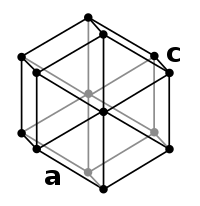
Photo from wikipedia
Hydrolytic dehydrogenation of ammonia borane is a significant and promising approach for on-site hydrogen production at ambient conditions, and developing highly efficient and low-cost catalysts has attracted considerable attention. Herein,… Click to show full abstract
Hydrolytic dehydrogenation of ammonia borane is a significant and promising approach for on-site hydrogen production at ambient conditions, and developing highly efficient and low-cost catalysts has attracted considerable attention. Herein, waste-biomass-derived activated carbon (AC) was prepared by hydrothermal carbonization and alkali-assisted activation, and non-precious bimetal phosphides (Co–Cu–P) nanocatalysts with a series of different Co/Cu ratios were synthesized on the AC surface through in situ phosphidation method. Owing to the synergetic effects, the optimal Co0.8Cu0.2P/AC presents an outstanding turnover frequency of 26.5 min−1 (25 °C), which is much higher than that of many reported catalysts. The reaction activation energy was measured to be 34.6 kJ mol−1. Benefiting from the ferromagnetic nature of the phosphides, the Co0.8Cu0.2P/AC can be magnetically separated and reused again. After recycling six times, the catalyst still retains 72% of the initial activity, thus indicating great potential for practical applications.
Journal Title: RSC Advances
Year Published: 2023
Link to full text (if available)
Share on Social Media: Sign Up to like & get
recommendations!